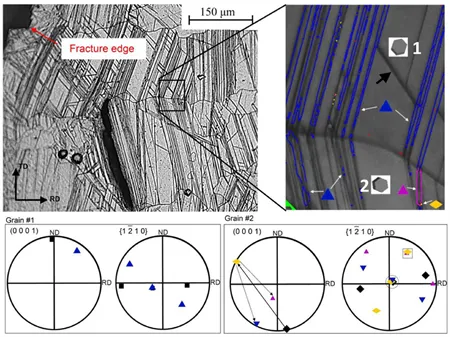P79: Double twinning in magnesium
Project Abstract
Deformation twinning is a phenomenon far from equilibrium in which a crystal responds to an applied stress by a change of shape. The twins grows up to the speed of sound within the metal: hence the cry (like a sonic boom). The physics is extremely complicated: the atoms react collectively to produce the change of shape. Mathematically the shape change is an affine transformation possessing an invariant plane. Recently it has been shown that the phenomenology of twinning can be rationalised and predicted using a topological model which describes the admissible interfacial defects and shows how they move. The topological model is based entirely in group theory.
That's the fundamentals. Our motivation is the design of magnesium alloys. Magnesium is the least dense of the structural light alloys but is much less ubiquitous that aluminium or titanium for a number of reasons. Its alloys may catch fire. They are very susceptible to corrosion (another highly non equilibrium process of great interest in my research group). They are very difficult to form by rolling and forging. Their crystal grain structure is strongly textured. In the last year it has been discovered that double twinning plays a central role in the development of rolling texture.
If you find twinning fascinating and complicated wait till you've studied double twinning. I want you to try and use the topological theory to come up with a detailed atomic scale description of double twinning in magnesium. Once we have the atomic picture we can use quantum mechanics to work out the energetics (topology and group theory can tell us nothing of energy, force or stress). This year a student in my group has worked out how to use first principles pair potentials to make molecular dynamics simulations in magnesium and some dilute alloys. If you know anything about molecular dynamics and electronic structure you may well be very skeptical. How can you properly describe the forces in metals with pair potentials? Well you can in the nearly free electron metals. Rigorously. In pseudopotential theory, to first order in the perturbation of the free electron gas, the ion-ion force is pairwise. Long ranged and oscillatory, yes; but pairwise.
Project Aims
We hope to come to a fully detailed understanding of double twinning in magnesium. This will be of great interest to our partner Magnesium Elektron. You will have the opportunity to fully engage with our colleagues there. You will also be trained within my research group in the necessary crystallography, dislocation theory, the use of computers and supercomputers and electronic structure of metals.
First you will have to learn crystallography, theory of plasticity, dislocation theory, elastic theory and the general classical theory of fields. Then you will need some group theory and topology. You will start with twinning and then we’ll move to double twinning. If our experimental partners cannot tell us the composition plane of the double twins (and they’ve not measured this at the time of writing) then we will propose possible invariant planes and predict the admissible line defects. From this we will construct a detailed description of the composition plane and explain how it is glissile: that is, how it can move approximately normal to itself, conservatively, and with no more than the resistance due to a friction stress. Once the topological model is established you will make atomistic models of the interface and use first principles quantum mechanically derived interatomic potentials to simulate in the computer the advance of the interface and the growth of the double twin. We know that the so called “rare earth texture” is dominated by the properties of double twins so we will then consider the effects of alloying elements on the mobility and stability of double twins. This last topic will require the use of modern electronic structure methods based in the density functional theory.

References
- RC Pond and JP Hirth, Solid State Physics, 47, 287, (1994)
- JP Hirth et al., Prog. Mat. Sci., 58, 749 (2013)
- A Serra et al., Acta Metall., 36, 3183 (1988)
- S Niknejad et al., Acta Mater., 102, 1 (2016)
- IJ Beyerlein et al., Proc. Roy. Soc. A, 468, 1496 (2017)
